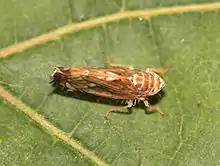Scaphoideus titanus
Scaphoideus titanus, or the American grapevine leafhopper, is an insect of the leafhopper family (Cicadellidae) which feeds on various plants of the family Vitaceae. Native to North America, it was introduced by accident to Europe where it has become a pest by acting as a vector of the grapevine phytoplasma disease flavescence dorée.[1] Mating requires species-specific vibrational patterns that males emit to the females, which are often victim to reproductive interference, including vibrational mating disruption caused by humans for pest control purposes.[2] Nymphs do not engage in vibrational communication.[3]
| Scaphoideus titanus | |
|---|---|
 | |
| Female S. titanus on a grapevine leaf | |
| Scientific classification | |
| Kingdom: | |
| Phylum: | |
| Class: | |
| Order: | |
| Suborder: | |
| Infraorder: | |
| Superfamily: | |
| Family: | |
| Subfamily: | |
| Tribe: | |
| Genus: | |
| Species: | S. titanus |
| Binomial name | |
| Scaphoideus titanus Ball, 1932 | |
References
- Papura, Daciana; et al. (2012). "Microsatellite and mitochondrial data provide evidence for a single major introduction for the Nearctic leafhopper Scaphoideus titanus in Europe". PLoS ONE. 7 (5): e36882. Bibcode:2012PLoSO...736882P. doi:10.1371/journal.pone.0036882. PMC 3356346. PMID 22629338.
- Zaffaroni-Caorsi, Valentina; Nieri, Rachele; Pugno, Nicola M.; Mazzoni, Valerio (July 2022). "Effect of vibrational mating disruption on flight activity and oviposition to control the grapevine pest, Scaphoideus titanus". Arthropod Structure & Development. 69: 101173. doi:10.1016/j.asd.2022.101173. PMID 35636340. S2CID 249143711.
- Chuche, Julien; Thiéry, Denis; Mazzoni, Valerio (July 2011). "Do Scaphoideus titanus (Hemiptera: Cicadellidae) nymphs use vibrational communication?". Naturwissenschaften. 98 (7): 639–642. Bibcode:2011NW.....98..639C. doi:10.1007/s00114-011-0808-x. PMID 21656005. S2CID 10203952.
This article is issued from Wikipedia. The text is licensed under Creative Commons - Attribution - Sharealike. Additional terms may apply for the media files.